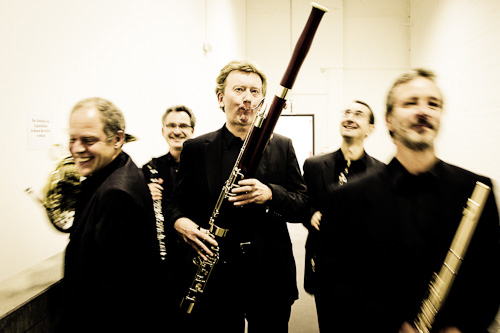direct to content: skip navigation
Navigation:

crescendo - the classical magazine February/March 2004
31 Franz Schubert (arr.Breuer): Arpeggione-Sonata/ Mussorgskij (arr.Linckelmann): Pictures at an Exhibition
This CD offers a new view of two wellknown compositions.
Herbert Breuer succeeds 90% percent of the time to create the illusion
of a genuine Schubertian wind composition, so that one occasionally believes
to be listening to an unknown chamber music work of the Viennese master.
Many details which perhaps are not so obvious in the original piano part
become clearly audible. Geringas plays the extremely difficult cello part
with ease and passion. The individual and collective virtuosity of the
players of the Wind Quintet of the Staatskapelle Berlin dominates the
Mussorgskij arrangment. The movements in Linckelmann's
arrangmnet vary in effictiveness. However, as a whole the transcription
is well worth listening to, provided it is played by musicians of this caliber.
CMS
Geringas, Bläserquintett der Staatskapelle Berlin, Grabner, Haase.
Sony Classical 513858-2
Newspaper WAZ - Kultur in Essen - 9-25-2002
Berliners Open the Season
The Bäserquntett der Staatskapelle Berlin gave the first Zollvereinskonzert of the
new season on Schacht Zwölf with works by Mozart, Barber, Arnold, and Mussorgsky.
Only a small audience came to the opening of the season to the Zollvereinskonzert series.
This was very regrettable in light of the artistic caliber of the wind ensemble of the
Staatskapelle Berlin. Thomas Beyer, flute, Gregor Witt, oboe, Heiner Schindler, clarinet,
and Axel Grüner, bassoon, were beautifully in sync with each other during the quintet
in c-minor (KV 406) by Wolfgang Amadeus Mozart. Heroically serious resounded the first
movement, dreamlike the the Andante, canonically strict the menuet, and finally cheerfully
relaxed the final variation. Eaqually apt as in this classical work were the young
musicians in the interpretation of of Samuel Barber's Summer Music, op.31 and Malcolm
Arnold's "Sea Shanties for Wind Quintet" op.4. With their spirited play and superior
style, the musicians brought out the individual unique tone of both works. Mussorgsky's
Pictures at an Exhibition, in an arrangement for five wind instruments, were played with
impressive sound. The audience showed their appreciation with standing ovations.
Hans Burkardt
Newspaper BNN - 9-24-2002
Between Soft Sounds and Expressive Contrast
The Bläserquintett der Staatskapelle Berlin gave a SWR (Southwest Radio Broadcast)
concert at the Asam Hall of the Ettlingen Castle
The Bläserquintett der Staatskapelle Berlin, founded in 1994, consisting of
Thomas Beyer, flute, Gregor Witt, oboe, Heiner Schindler, clarinet, Ingo Reuter,
bassoon, and Axel Grüner, horn, playing together excellently, by invitation of SWR
Karlsruhe and the cultural office of the city of Ettlingen, gave in the Asam Hall
an enthusiastically received performance. The musicians began with the Quintet
in c-minor, KV 406, by Mozart. Playing extremely disciplined, the first movement
was very flowing, the andante decidedly warm and soft in tone, and after the finely
structured menuetto the ensemble gave each variation of the finale its individual
color, ending in a cheerful mood. Open to all musical styles, the quintet followed
up with Summer Music op.31 by the American composer Samuel Barber (1910-1981), music
which is full of contrasts, very calm in part, and rhythmically poignent in other parts.
Here the rhythmical exacting and dynamic elasticity of the quintet were especially apparent.
The sassy rendition of the overture to "Die Fledermaus" by Johann Strauss was
not without musical finesse. The five gentlemen possess a great sense for musical
humor which was proven in the virtuoso "Three Sea Shanties" by the British composer
Malcolm Arnold, born in 1921, which the wind players performed technically superior
and with great dramatic enthusiasm. Particularly hilarious was the "Opus number zoo".
Luciano Berio's composition of characerizing music to four animal stories, written by
Rhoda Levine. The poems, somewhat reminiscend of Ringelnatz, were recited by the
players during and inbetween movements. They were about such things as a fox dancing
with a chicken, a gray mouse, or the fight between two cats. The fun which the players
had immediately transpired to the audience. Even with the last piece of the program,
the Quintet No.1 by Jean Francaix, who is known for his light and graceful, often
humorous style, the ensemble did not deny itself to playful humor. This dazzeling
performance drew rousing final ovations, which were followed by highly impressive encores.
Christiane Voigt

